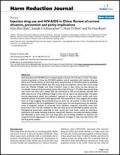Publications - Released in 2006
Illicit drug abuse and HIV/AIDS have increased rapidly in the past 10 to 20 years in China. This paper reviews drug abuse in China, the HIV/AIDS epidemic and its association with injection drug use (IDU), and Chinese policies on illicit drug abuse and prevention of HIV/AIDS based on published literature and unpublished official data.
As a major drug trans-shipment country with source drugs from the "Golden Triangle" and "Gold Crescent" areas in Asia, China has also become an increasingly important drug consuming market. About half of China's 1.14 million documented drug users inject, and many share needles. IDU has contributed to 42% of cumulatively reported HIV/AIDS cases thus far. Drug trafficking is illegal in China and can lead to the death penalty. The public security departments adopt "zero tolerance" approach to drug use, which conflict with harm reduction policies of the public health departments. Past experience in China suggests that cracking down on drug smuggling and prohibiting drug use alone can not prevent or solve all illicit drug related problems in the era of globalization. In recent years, the central government has outlined a series of pragmatic policies to encourage harm reduction programs; meanwhile, some local governments have not fully mobilized to deal with drug abuse and HIV/AIDS problems seriously. Strengthening government leadership at both central and local levels; scaling up methadone substitution and needle exchange programs; making HIV voluntary counseling and testing available and affordable to both urban and rural drug users; and increasing utilization of outreach and non-governmental organizations are offered as additional strategies to help cope with China's HIV and drug abuse problem.
Downloads
Organizations
- BioMed Central (BMC)






